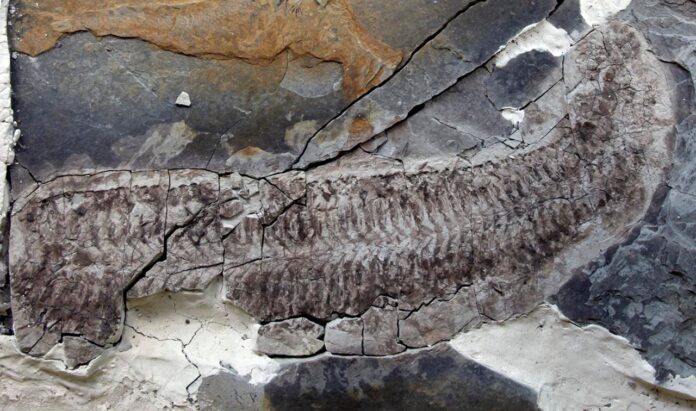A groundbreaking discovery in South Africa’s Soom Shale has revealed an ancient arthropod species, Keurbos susanae, dating back to the Upper Ordovician period, approximately 445 million years ago. This exceptionally preserved fossil offers a rare glimpse into the internal anatomy of early arthropods, including their muscles and connective endoskeleton. The findings, published in Papers in Palaeontology, provide valuable insights into the evolution of arthropods and the unique conditions that allowed for such remarkable fossil preservation.
What Was Discovered?
The new species, Keurbos susanae, is a type of euarthropod—a group that includes modern insects, crustaceans, and arachnids. Researchers uncovered two specimens of this ancient creature in the Soom Shale Konservat-Lagerstätte, a fossil-rich site in South Africa known for its exceptional preservation of soft-bodied organisms.
Unlike most fossils that primarily preserve external features like shells or exoskeletons, these specimens are unique because they retain detailed internal structures. The fossils show three-dimensional preservation of muscles and parts of the connective endoskeleton. This is unusual because internal tissues typically decay quickly after an organism dies. In this case, the fossils reveal intricate details such as axial sternites (internal skeletal plates) and muscle fibers, offering a rare opportunity to study the internal anatomy of an extinct arthropod.
Why Is This Discovery Important?
This discovery is significant for several reasons:
- Understanding Arthropod Evolution: Arthropods are one of the most diverse and successful groups of animals on Earth. By studying Keurbos susanae, scientists can better understand how early arthropods evolved and how their body structures adapted over millions of years.
- Unique Fossil Preservation: The fossils exhibit what researchers call “reverse taphonomy.” Normally, hard external structures like exoskeletons are well-preserved while soft internal tissues decay. However, in these fossils, the internal anatomy is preserved in stunning detail while the exoskeleton is poorly expressed or absent. This rare preservation style provides a unique window into the biology of ancient organisms.
- Insights into Ancient Ecosystems: The Soom Shale was deposited during a time of significant global change at the end of the Ordovician glaciation event. Studying fossils from this period helps scientists reconstruct ancient ecosystems and understand how life adapted to changing environmental conditions.
How Was It Preserved?
The exceptional preservation of Keurbos susanae is attributed to the unique conditions of the Soom Shale. This geological formation was deposited in a shallow marine basin influenced by glacial activity. Fine-grained sediments, combined with low oxygen levels at the seafloor, created an environment where soft tissues could be mineralized before they decayed.
The fossils were preserved through mineral replacement, where original tissues were replaced by minerals like calcium phosphate and clays. This process captured fine details of muscles and other internal structures in three dimensions, making these fossils some of the best-preserved examples of early arthropod anatomy.
What Did Scientists Learn About Keurbos susanae?
The two specimens studied reveal several key features:
- The body consists of 46 segments that taper toward the tail.
- The dorsal surface includes rounded folds along the sides.
- Internal structures like muscles and connective plates are preserved in three dimensions.
- External appendages, such as legs or antennae, are poorly preserved or absent.
These features suggest that Keurbos susanae may belong to the crown group of euarthropods (modern arthropods) rather than their evolutionary ancestors. However, its exact placement on the arthropod family tree remains uncertain due to incomplete data on its head and appendages.
How Is This Useful Today?
The discovery has practical implications beyond paleontology:
- Advancing Fossil Research Techniques: The study demonstrates how advanced imaging technologies like scanning electron microscopy (SEM) and X-ray fluorescence (XRF) can reveal details about ancient life that were previously inaccessible.
- Understanding Biodiversity Resilience: By studying how organisms like Keurbos susanae survived and thrived during periods of environmental upheaval, scientists can draw parallels to modern biodiversity challenges caused by climate change.
- Inspiring Biomimicry: Understanding how early arthropods’ internal structures functioned could inspire innovations in engineering or robotics, particularly in designing lightweight yet strong materials or systems.
A Glimpse Into Earth’s Distant Past
The discovery of Keurbos susanae is a testament to the power of paleontology to uncover Earth’s deep history. These fossils not only shed light on the evolution of one of Earth’s most successful animal groups but also highlight the extraordinary conditions required for such preservation.
As researchers continue to study these specimens and search for additional fossils, they hope to uncover more details about this enigmatic species and its place in the tree of life. For now, Keurbos susanae stands as a remarkable example of how life has adapted and thrived through Earth’s many changes over hundreds of millions of years.
This discovery reminds us that even after centuries of exploration, our planet still holds secrets waiting to be uncovered—secrets that can teach us about both our past and our future.








